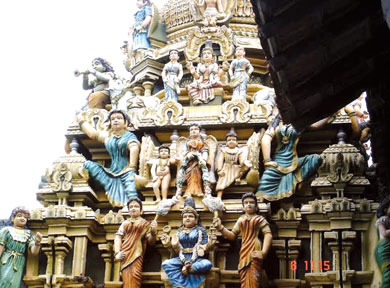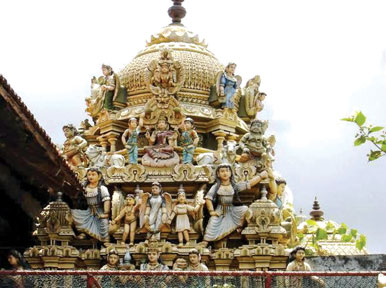|
Hindu temple sculptures:
Unique creations
By Subashini Pathmanathan
Most Sri Lankan sculptures can be divided into different categories.
Some are stone-made sculptures and others are metal-made including
copper, gold, silver and five mixed metal sculptures which are known as
iyempon sculptures in Tamil. Even the stone sculptures are further
divided into granite stone sculptures, modern cement made sculptures and
marble sculptures. Hindu temples are famous for tower sculptures
referred to as temple Kopuram sculptures in Tamil.
 The Hindu temple towers could be identified at a long distance. The
height of the Hindu temples is determined by the number of bases which
is referred to in Tamil as Thalams. The Hindu temple towers could be identified at a long distance. The
height of the Hindu temples is determined by the number of bases which
is referred to in Tamil as Thalams.
Some Hindu temples have three or five Thalams. Some have seven and
the highest Thalams number is nine. When the number of Thalams increases
the height of Kopurams also increases.
The sculptures are long lasting. However, there are ivory, wooden and
clay sculptures available at ancient archaeological sites and
temples.These temple sculptures could be divided into different
categories.
One is worshipping temple sculptures and the other is the temple
decorative sculptures which could be seen on the temple pillars,
rooftops, temple towers, temple walls and pillars. The Hindu temples are
famous for tower sculptures referred to as temple Kopuram sculptures in
Tamil.
The tall Kopurams (towers) of the temples are full of sculptures.
Within the temples, on temple pillars, walls and rooftops there are
plenty of sculptures around the Mandapams and Madams. Most temple tower
sculptures and temple Vimana (building structure over Gadpagraha) depict
numerous puranic stories and epics related to the main presiding deity
of the temple.
The sculptures in the temples mainly depict the dance poses of
various gods as well as humans.
Among all the temple sculptures, the most famous sculptures depict
the female dancing figures.
Among all these decorative temple sculptures different poses of
animals reptiles, creepers and lotus flowers are often seen.
Almost every Hindu temple structure all over the world follows the
South Indian Dravidian temple structural architecture and style.
For instance, in Kaali temples Kaali sculptural figures and paintings
decorate the inner temples.
Kopurams
Similarly, at Shivan temples 108 Thandava Karans and Shiva Purana
related sculptures decorate the inside and outside Kopurams of the
temples. In Vaishnava temples Vishnu Puranic sculptures and stories 31
related to Lord Krishna decorate the temples.
Even the Hindu temple architecture of Sri Lanka more or less follows
the Tamil Nadu and Andhra Hindu temple structure. According to Hinduism,
the temple architectural pattern and structure should follow certain
Hindu Sastras and Agamas.
Even the Bharatha Natyam repertoire should also follow the same
architectural structural order of Hindu temples.
The Indian Hindu temples as compared with those in Sri Lanka are
quite large. The Indian Hindu temples have large corridors and fairly
big art galleries.
And the sculptures have different body and neck positions, glances,
hand positions, hand gestures and stands and foot positions.
 Among all the temple sculptures Nallur Kaillasa Pillaiyar temple at
Jaffna, temple sculptures are quite different from other Hindu temple
sculptures. Among all the temple sculptures Nallur Kaillasa Pillaiyar temple at
Jaffna, temple sculptures are quite different from other Hindu temple
sculptures.
Generally the Hindu temple sculptures have a typical Dravidian
influence. But at Nallur Kaillasa Pillaiyar temple is much influenced by
western art.
It is an amazing fact that at this temple the female sculptures
resemble the fairies and angels. Some of the female sculptures are seen
with frocks.
Vimanams
The figures are seen over the Vimanams. These sculptures might have
been built during the British regime or when the country was under
foreign rule. So far there is not much trace of foreign influence in any
other Hindu temple Kopuram sculptures or Hindu Vimanams.
According to historical facts, king Singai Pararagasekaran who ruled
Jaffna in 1478 built four important temples in his kingdom. Originally
four temples were built by him in his kingdom for protection.
The Nallur Kailas Pillaiyar temple was built on the Southern
direction; on the Northern side Nallur Satanathar temple was built by
the king and the Veiulukanda Pillaiyar Kovil was constructed on the
eastern side and on the West Veera Maha Kaalai temple was built up.
During the Portuguese period many Hindu temples in the peninsula were
destroyed.
Yet all the temples were rebuilt during different periods. During the
alien rule their alien customs and cultural influences would have been
penetrated into exceptional temple sculptures.
As compared to the other Hindu temple sculptures Nallur Kailas
Pillaiyar Hindu temple Vimana sculptures are quite different.
It could be considered exceptional and it is very much influenced by
alien factors among the Hindu temples of Sri Lanka.So far nobody has
mentioned this fact in Sri Lanka. |

